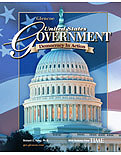U. S. Government: Democracy In ActionChapter 16:
Political PartiesWeb Activity Lesson PlansIntroduction
In this chapter students learned about the role of political parties in United States politics, the organization and function of political parties, and the four methods of nominating candidates to political office. In this activity they will take a closer look at the rise of the party system and how it has impacted United States politics. Lesson Description
Students will visit the Library of Congress's Web site featuring information on political parties in the United States. They will learn about the reasons parties form and will read about the various parties that have risen and faded throughout our nation's history. Students will then write a one-minute speech in which they try to convince people to join the new party they have formed. Instructional Objectives - Students will be able to explain causes for the formation of political parties.
- Students will be able to describe some of the political parties that have existed throughout our nation's history.
Student Web Activity Answers - The unique conditions of different historical eras and the differing ideologies in the United States combine to give rise to political parties. Parties form to work toward specific goals and to elect candidates who represent these goals.
- The first two parties were the Federalists and the Democratic-Republicans. These parties formed to support or oppose the proposed Constitution of the United States.
- The first "third party" formed was the Anti-Masons. It set a precedent by holding the first party convention that nominated candidates.
- Students' responses will vary.
- Students' parties and speeches will vary.
 | 




